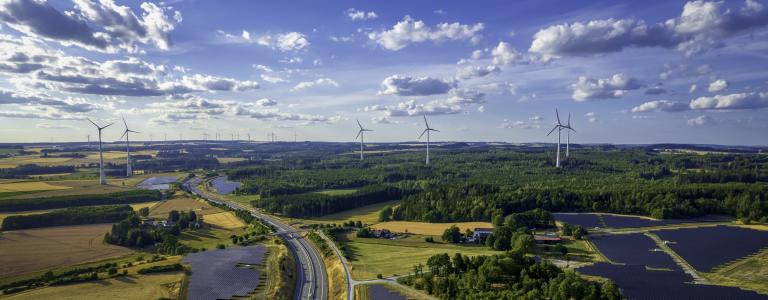Planned New Oil and Gas Investments, Incompatible with 1.5°C Warming Limit, Could Fully Finance Wind and Solar Scale-Up to Curb Climate Change
October 24, 2022—Projected investments in new oil and gas fields by 2030, incompatible with limiting global warming to 1.5°C, could fully finance the wind and solar energy ramp-up required to stay within meet this target, finds a new report by the International Institute for Sustainable Development (IISD) released today.
The study, Navigating Energy Transitions: Mapping the Road to 1.5°C, finds that USD 570 billion will be spent on new oil and gas development and exploration every year by 2030. Shifting these finances to renewable energy could fully bridge the USD 450 billion annual investment gap for wind and solar deployment required to effectively displace oil and gas production in line with the 1.5°C limit that would reduce the worst impacts of climate change, experts found.
The report—which provides the first-ever comparison of a large number of climate and energy pathways to outline what is needed to limit global warming to 1.5°C—highlights that developing any new oil and gas fields would either push the world beyond the limit or create stranded assets.
Redirecting financing from oil and gas toward renewables is therefore imperative to enable a shift in the energy sector and keep global temperature increases in check.
“There is no shortage of available capital for the energy transition; the problem is rather that energy investment is going to the wrong places, massively funding new oil and gas fields instead of renewables,” said Olivier Bois von Kursk, Policy Advisor at IISD and lead author of the report. “Governments must enable environments for redirecting both public and private capital flows toward the clean energy transition.”
The International Energy Agency (IEA) has shown that there can be no new fossil fuel projects if the world is to stay within the 1.5°C limit on global warming. This conclusion has sparked pushback from some countries, banks, and the industry, who have called this approach “too narrow.”
The IISD report shows that all major 1.5°C scenarios map a similar trajectory to the IEA’s. The pathways indicate that global oil and gas production must decrease by at least 65% between 2020 and 2050 and up to 99% when considering scenarios excluding all carbon sequestration technologies.
Europe can meet its energy demand without Russian gas within two years.
Europe’s dash for gas to replace Russian supplies is at odds with its commitments to fight climate change, argue the authors of the report. Even without Russian gas, Europe’s existing gas-importing capacities are, in fact, enough to meet the continent’s 1.5°C-compatible energy demand—as projected by the European Commission's REPowerEU plan—from 2024 onward.
Adding new gas infrastructure in Europe is a false solution to address the short-term supply crunch, experts warn, because it will not be operational in time to help European citizens navigate the upcoming two winters. Instead, it would risk putting the 1.5°C goal even further out of reach or creating stranded assets for newly built infrastructure in Europe and in gas-exporting countries, such as Africa.
Angela Picciariello, Senior Researcher at IISD and co-author of the report, said: “Beyond 2024, not only can Europe meet its energy needs without Russian gas supply, it must do so to align with 1.5°C pathways.”
“The recent push for new oil and gas—in the United Kingdom, Italy, Germany, and elsewhere—is exactly the opposite of what countries should be doing to build a resilient energy supply system that will shield consumers from geopolitical risks and energy market fluctuations in the long term,” Picciariello said.
The answer to reducing Europe’s dependence on Russian gas lies in accelerating renewable energy, energy efficiency, and electrification, the authors of the report recommend.
Diala Hawila, Programme Officer at International Renewable Energy Agency (IRENA), said: "The report provides a very timely and comprehensive analysis of how the world can transition to a more sustainable, clean and resilient energy system. It shows the convergence of multiple scenarios towards the need for a comprehensive policy framework to ensure the transition benefits countries worldwide."
Media contacts
Olivier Bois von Kursk, Policy Advisor, IISD: oboisvonkursk@iisd.ca
Angela Picciariello, Senior Researcher, IISD: apicciariello@iisd.org
Aia Helena Brnic, Communications Officer, IISD: abrnic@iisd.org
About IISD
The International Institute for Sustainable Development (IISD) is an award-winning independent think tank working to accelerate solutions for a stable climate, sustainable resource management, and fair economies. Our work inspires better decisions and sparks meaningful action to help people and the planet thrive. We shine a light on what can be achieved when governments, businesses, non-profits, and communities come together. IISD’s staff of more than 250 experts come from across the globe and from many disciplines. With offices in Winnipeg, Geneva, Ottawa, and Toronto, our work affects lives in nearly 100 countries.
You might also be interested in
Shifting S. Africa coal plant for clean energy needs millions in loans. Experts say that's a problem
Plumes of heat-trapping pollutants last billowed from the giant stacks of Komati Power Station in October, when the coal-fired plant that fed South Africa's hungry electrical grid for more than half a century was shut down to make way for a solar, wind and battery storage plant.
Carbon Minefields: Oil and gas exploration surging to pre-Covid levels
Oil and gas exploration is booming despite an agreement at last year’s COP 28 climate summit to transition away from fossil fuels.
July Edition | Carbon Minefields Oil and Gas Exploration Monitor
In June 2024, six governments issued 18 oil and gas exploration licences with embodied emissions of 14.7 MtCO2, led by Russia and China.
Border Carbon Adjustments: Trinidad and Tobago country report
This report consolidates, analyzes, and presents views and perspectives of stakeholders from Trinidad and Tobago on border carbon adjustment (BCA) schemes to contribute to the global debate on BCA good practices.
